Mish Mash
/_______
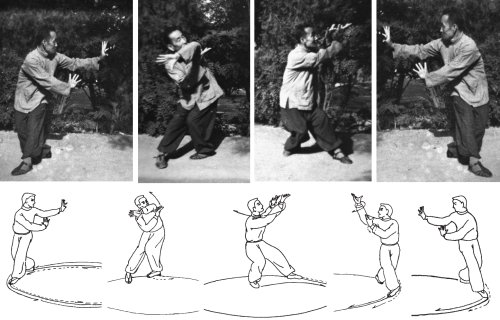
I love this picture series of Liu Fengcai doing Baguazhang.
In these pictures he is emphasizing polarity in his body created by the combination of "monkey doesn't want to go to school" and "effortlessly floating the head upward." The two forces create extraordinary external wrapping of the soft tissue around the torso and the backs of the legs-- this is evident in the shape of his hands. Sweet. (The artist's sketch underneath is an unnecessary distraction, but notice he added the drawing 4th from the left which breaks several baguazhang rules. The arrows are misleading too.)
____________
Only Comics and Dogs Wiggle their Head!
For all the hemming and hollering I’ve heard over the years about the importance of keeping the head upright as well as contrary opinions in favor of practicing dodging and ducking with the head, I am delighted to let everyone know that the controversy was created entirely from the denial of gongfu’s theatrical origins.
Here is a video of me doing an 8 part warm up that came from Kuo Lien-ying which I have been doing for 30 years. After reading Jo Riley's book Chinese Theater and the Actor in Performance. I've changed three of the movements slightly (I'll have to make a new video). I'm very sure that I've been doing the exercises slightly wrong for all these years because I was limited in my view and simply didn't understand the original instructions.
Number 2 in the series is for training the basic heroic stance and should be done with the chest lifted more than you see here.
Number 3 is the basic comic stance and should be done with the tailbone back, the belly out, the arms straighter, and the head lifted. In this position it is OK if the head wiggles because that's what comics and dogs do to show their lower statues. It's so much better this way.
Lastly the 8th stance, usually called "chin to toe," is used as a mind clearing exercise by performers back stage immediately before they perform. It should be done with the kidneys forward, not back as I've shown in the video. Thanks Jo, that tiny bit of information unlocked a lot of secrets for me. (Yes, there are secrets.)
__________
Disheveled and in disarray...
is a good description of all of my Daoist studies, as well as all my “progress” in martial arts. I have followed my teachers in trying to transmit brilliant structures, orders, and systemizations in my writings. However; the reality is a lopsided, languid, sometimes choppy, sometimes flowing, unwieldy beast.
Occasionally I pick up a comment saying I'm too organized. Reality doesn't fit in boxes. Thanks for pointing that out. All systemizations are also limitations. All stated orders are incomplete. The truth is always available in completely undifferentiated chaos (huntun), just waiting for you to stick your head in there and pull it out.
Occasionally I have received friendly comments here and on various forums which describe my thinking as mystical. While I realize it is silly of me to take umbrage at this, it does rub me the wrong way. I’m not personally interested in a mystical journey. I’m not declaring that everything I say is a concrete metaphor, yes, my metaphors are sometimes misty or even foggy; but I am not on a mystical journey. Sometimes looking in at something new or foreign from the outside creates a mystical feeling in the observer, that's fine, but please tell me if you think I’ve become rooted in anything less than what is absolutely real.
___________
Chinese Martial Arts are a treasure...
but they are a changing treasure. The Daodejing mentions three unchanging treasures, hold and preserve them!
The first is compassion. (We're talking predator drone, Buffy the Vampire Slayer, in the thick-of-it, compassion-- not moral platitudinous, bumper-sticker yoga compassion like, "Do no harm.")
The second is conservation. (No not greenness people! I’m (in the) black and I’m proud! Business is the most effective social mechanism for conservation ever-- cut your costs, improve your efficiency-- now let excess, laziness, misty eyed romantics, hysterical greenies, and inferior products and services die.)
The third is not imagining yourself to be at the center of the world. (Duh!)
The three treasures do not lend themselves to fame, or charisma, or even claims of authorship. Each person, or family, or community, or nation, or institution can find its own way to express these treasures. But it's not hard to see why one might be inspired to live like a hermit.
____________
Cold! Lively!
I love being outside this time of year! When the temperature drops the surface of my body cools down, but the inside stays hot. This is an ideal condition for cultivating the Daoist elixir practice (jindan) and martial arts in general. Why? Because jing and qi differentiate more easily. Our structure, the heavy stuff we are made of, jing, is easier to feel and therefore relax because it is cold on the surface. And our qi, the activity, the motion, the animation, is more obvious on the inside. It hums and vibrates. Explosive power is more available. In stillness the qi wiggles deeper into the bones, making whatever it is you practice irreversible. People who get lazy about their practice in the winter months miss out on the best season. THE BEST!
_________
Here are some websites I found interesting:
http://www.chinesewudangboxing.com/aboutus.htm
http://www.fathom.com/course/21701773/sessions.html
http://www.nexthomegeneration.com/Han_Dynasty#Eastern_Han
OK my home-slices, keep it real.

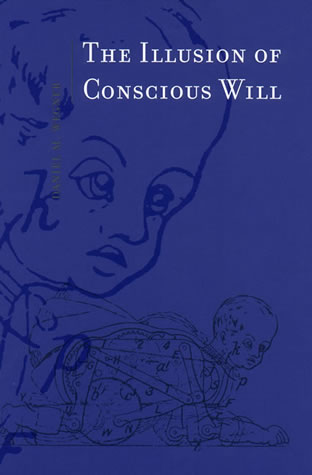 Wow, isn’t it ironic that I sometimes want to write about something but can’t find the words. It’s actually so common an experience that we hardly even notice the irony. It’s as if I have to not care too much to be able to write. I have to let go, or trick my conscious will out of the way to improvise the actual text through my fingertips. Martial arts have similar requirement; and healing does too. I suppose that letting go is the fruition of non-conceptual meditation. Is the ability to improvise is an indicator that a person is seeing things as they actually are?
Wow, isn’t it ironic that I sometimes want to write about something but can’t find the words. It’s actually so common an experience that we hardly even notice the irony. It’s as if I have to not care too much to be able to write. I have to let go, or trick my conscious will out of the way to improvise the actual text through my fingertips. Martial arts have similar requirement; and healing does too. I suppose that letting go is the fruition of non-conceptual meditation. Is the ability to improvise is an indicator that a person is seeing things as they actually are?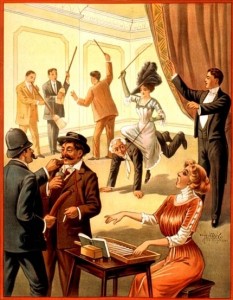 He concludes that conscious will is an illusion, we feel like we are willing our actions because our actions usually correspond with our experience of willing them, not because our conscious will actually causes our actions. But conscious will is like a compass on a boat. It tells us where we are going, makes us feel guilty so that we change course, or proud so that we charge ahead. It manages our preferences.
He concludes that conscious will is an illusion, we feel like we are willing our actions because our actions usually correspond with our experience of willing them, not because our conscious will actually causes our actions. But conscious will is like a compass on a boat. It tells us where we are going, makes us feel guilty so that we change course, or proud so that we charge ahead. It manages our preferences. Thus, if we want our jing, our structure body, to be free, it must follow the qi; but if the qi leads, our fighting techniques will stagnate at the developmental level of a 2 year old. So, we say, the spirits (shen) must lead the qi. What are the spirits? Perhaps they are a blend of our imagination and the kinesthetic experience of our environment, without the conscious will?
Thus, if we want our jing, our structure body, to be free, it must follow the qi; but if the qi leads, our fighting techniques will stagnate at the developmental level of a 2 year old. So, we say, the spirits (shen) must lead the qi. What are the spirits? Perhaps they are a blend of our imagination and the kinesthetic experience of our environment, without the conscious will?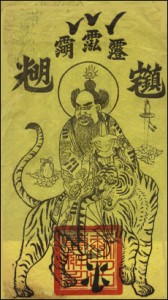 I have written elsewhere about martial arts forms being an
I have written elsewhere about martial arts forms being an  Confucianism is founded on the idea that we inherit a great deal from our ancestors, including body, culture, and circumstance. We also, to some extent, inherit our will, our intentions, and our goals. The Confucian project is predicated on the idea that we have a duty to carryout and comprehend our ancestors' intentions in a way which is coherent with our own circumstance and experiences. In practice, it is entirely possible that we have two ancestors who died with conflicting goals, or an ancestor who died with an unfulfilled desire, like unrequited love, or an ancestor who wished and plotted to kill us. Our dead ancestors have become spirits whose intentions linger on in us to some extent in our habits and our reactions to stress. It is the central purpose of Confucianism to resolve these conflicts and lingering feelings of distress through a continuous process of self-reflection and upright conduct--so that we may leave a better world for our descendants. The metaphor is fundamentally one of exorcism. We empty ourselves of our own agenda so that we might consider the true will of our ancestors (inviting the spirits), then we take that understanding and transform it into action (dispersion and resolution). Finally we leave our descendants with open ended possibilities, support, and clarity of purpose (harmony, rectification, unity).
Confucianism is founded on the idea that we inherit a great deal from our ancestors, including body, culture, and circumstance. We also, to some extent, inherit our will, our intentions, and our goals. The Confucian project is predicated on the idea that we have a duty to carryout and comprehend our ancestors' intentions in a way which is coherent with our own circumstance and experiences. In practice, it is entirely possible that we have two ancestors who died with conflicting goals, or an ancestor who died with an unfulfilled desire, like unrequited love, or an ancestor who wished and plotted to kill us. Our dead ancestors have become spirits whose intentions linger on in us to some extent in our habits and our reactions to stress. It is the central purpose of Confucianism to resolve these conflicts and lingering feelings of distress through a continuous process of self-reflection and upright conduct--so that we may leave a better world for our descendants. The metaphor is fundamentally one of exorcism. We empty ourselves of our own agenda so that we might consider the true will of our ancestors (inviting the spirits), then we take that understanding and transform it into action (dispersion and resolution). Finally we leave our descendants with open ended possibilities, support, and clarity of purpose (harmony, rectification, unity).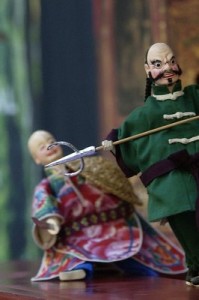 Daoist Meditation takes emptiness as it’s root. All Daoist practices arise from this root of emptiness. The main distinction between an orthodox Daoist exorcism and a less than orthodox exorcism is in fact the ability of the priests to remain empty while invoking and enlisting various potent unseen forces (gods/demons/spirits/ancestors) to preform the ritual on behalf of a living constituency, or the recently dead.
Daoist Meditation takes emptiness as it’s root. All Daoist practices arise from this root of emptiness. The main distinction between an orthodox Daoist exorcism and a less than orthodox exorcism is in fact the ability of the priests to remain empty while invoking and enlisting various potent unseen forces (gods/demons/spirits/ancestors) to preform the ritual on behalf of a living constituency, or the recently dead.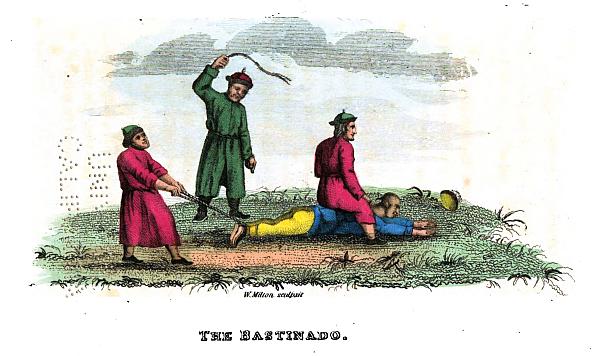 Jason Couch of Martial History Magazine sent me this article he put together
Jason Couch of Martial History Magazine sent me this article he put together  The Uncarved Block is one of the primary metaphors for the concept/anti-concept known as wuwei. The Daodejing suggests that we be like an uncarved block of wood. The implication is that once a block of wood is fashioned into something, it loses it’s potential to be something else. Once we make a decision, it cuts off certain options. In other words, it is often good to wait. But the Daodejing isn’t telling us to be indecisive. It doesn’t say, “in difficult situations--waver!” It also doesn’t say be slow, like a tree; or “be inactive,” like a log or a stump. It says be like a partially processed block of wood. Since the Daodejing doesn’t give us any idea how big this block of wood might be, or what it might be for, we can speculate. Our block of wood could be carved into any sort of deity or icon, or perhaps a boat, a cabinet, a ladle, or a coffin. The Daodejing is using this metaphor to point to a process which takes place when we make something. It is not saying, “Don’t make stuff.” Sometimes a decision can position us for more possibilities, sometimes a decision can limit us. Is this better than that? Be comfortable with ambiguity, but have a few uncarved blocks hanging around in case you need them.
The Uncarved Block is one of the primary metaphors for the concept/anti-concept known as wuwei. The Daodejing suggests that we be like an uncarved block of wood. The implication is that once a block of wood is fashioned into something, it loses it’s potential to be something else. Once we make a decision, it cuts off certain options. In other words, it is often good to wait. But the Daodejing isn’t telling us to be indecisive. It doesn’t say, “in difficult situations--waver!” It also doesn’t say be slow, like a tree; or “be inactive,” like a log or a stump. It says be like a partially processed block of wood. Since the Daodejing doesn’t give us any idea how big this block of wood might be, or what it might be for, we can speculate. Our block of wood could be carved into any sort of deity or icon, or perhaps a boat, a cabinet, a ladle, or a coffin. The Daodejing is using this metaphor to point to a process which takes place when we make something. It is not saying, “Don’t make stuff.” Sometimes a decision can position us for more possibilities, sometimes a decision can limit us. Is this better than that? Be comfortable with ambiguity, but have a few uncarved blocks hanging around in case you need them.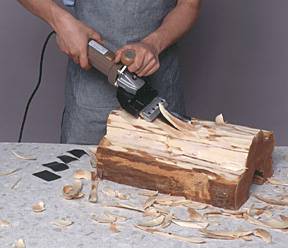
 The moment I start writing a blog post, or you start reading one, the danger that we will lose sight of wuwei increases. Because reading and writing is a form of carving. The moment we put pen to paper we risk crossing over into the land of methods.
The moment I start writing a blog post, or you start reading one, the danger that we will lose sight of wuwei increases. Because reading and writing is a form of carving. The moment we put pen to paper we risk crossing over into the land of methods.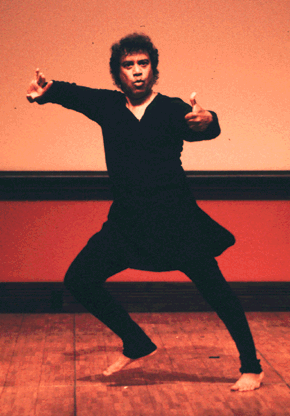 gfu on the brain.” It’s a possibility, I admit. Sometimes I get excited and I start to see martial arts in everything (Richard Rorty would call it the narcissistic tendency of powerful ideas). I can use Kungfu power to scrub the dishes. I can use maximum muscle tendon twisting to wring-out the laundry. I can set the table “the way a beautiful woman would do it,” (that’s an alternate name for Baguazhang seventh palm change).
gfu on the brain.” It’s a possibility, I admit. Sometimes I get excited and I start to see martial arts in everything (Richard Rorty would call it the narcissistic tendency of powerful ideas). I can use Kungfu power to scrub the dishes. I can use maximum muscle tendon twisting to wring-out the laundry. I can set the table “the way a beautiful woman would do it,” (that’s an alternate name for Baguazhang seventh palm change). I’ve had a taste of several different styles of African and African Diaspora Dances but my actual training was in Congolese and African-Haitian Dance. My Congolese Dance teacher, Malonga Casquelourd, learned to dance from soldiers on army bases.
I’ve had a taste of several different styles of African and African Diaspora Dances but my actual training was in Congolese and African-Haitian Dance. My Congolese Dance teacher, Malonga Casquelourd, learned to dance from soldiers on army bases. 
 As someone whose job it is to translate ideas from one culture to another, the pressure to use more familiar language is always floating around in the background.
As someone whose job it is to translate ideas from one culture to another, the pressure to use more familiar language is always floating around in the background. Basic structure training in Internal Martial Arts gets us to stop using these three big muscles for stabilization by getting us to put our weight directly on our bones. The other 400 or so smaller muscles in our bodies are then used to focus force along our bones through twisting, spiraling and wrapping. In that sense, the early years of internal martial arts training teaches us to use our muscles like ligaments; or put another way, the primary function of the smaller muscles becomes ligament support. (To develop this capacity in ones legs requires many years of training.)
Basic structure training in Internal Martial Arts gets us to stop using these three big muscles for stabilization by getting us to put our weight directly on our bones. The other 400 or so smaller muscles in our bodies are then used to focus force along our bones through twisting, spiraling and wrapping. In that sense, the early years of internal martial arts training teaches us to use our muscles like ligaments; or put another way, the primary function of the smaller muscles becomes ligament support. (To develop this capacity in ones legs requires many years of training.)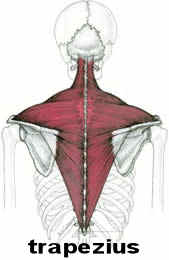 The three big muscles are already so big they don’t need to be strengthened but they do need to be enlivened. All three muscles should be like tiger skin or octopi, able to expand and condense and move in any direction. They then can take over control of the four limbs in such a way that movement becomes effortless--even against a strongly resistant partner. If you accomplish this all of your smaller muscles will be doing the task of transferring force to the three big muscles---preventing an opponent from being able to effect your body through your limbs. Yet whenever your limbs make contact with your opponent, he will be vulnerable to the force of your three big muscles.
The three big muscles are already so big they don’t need to be strengthened but they do need to be enlivened. All three muscles should be like tiger skin or octopi, able to expand and condense and move in any direction. They then can take over control of the four limbs in such a way that movement becomes effortless--even against a strongly resistant partner. If you accomplish this all of your smaller muscles will be doing the task of transferring force to the three big muscles---preventing an opponent from being able to effect your body through your limbs. Yet whenever your limbs make contact with your opponent, he will be vulnerable to the force of your three big muscles.
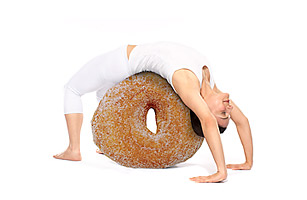 A while back I wrote a post called,
A while back I wrote a post called,  Here is an article from the NYT about
Here is an article from the NYT about 